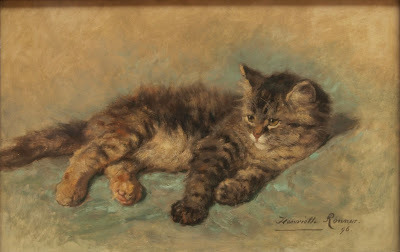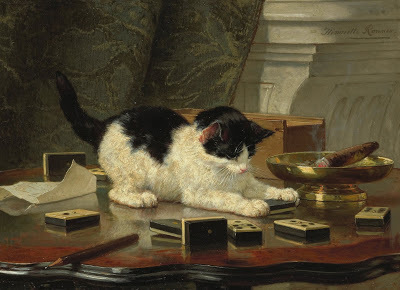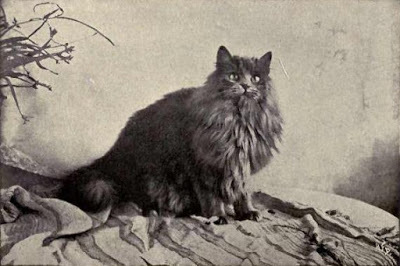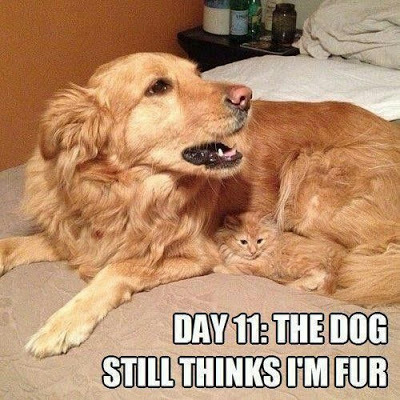Cat-egorizing Cats 19th Century Style
How do you organize cats?
Last week in How the Victorians went Wild for Cat Shows we looked at the popular 19thcentury pastime of visiting dog or cat shows. However, the organizers of cat shows had a problem that dog show organizers did not have, which was how to group the entries. With dogs it was relatively easy because they came in so many varied sizes and shapes or breeds. Cats – not so much. A tortoiseshell and white cat by Louis WainCat fancier Harrison Weir, arranged the very first cat show, which took place at Crystal Palace, July 16, 1871. His stated aim as organizer in “a labor of love to the feline race,” was to draw attention and therefore favor to: “The different breeds, colors, markings.”
A tortoiseshell and white cat by Louis WainCat fancier Harrison Weir, arranged the very first cat show, which took place at Crystal Palace, July 16, 1871. His stated aim as organizer in “a labor of love to the feline race,” was to draw attention and therefore favor to: “The different breeds, colors, markings.”
However, Weir had a problem because the existing description of cat breeds tended to dwell on distinctions that highlighted their weaknesses. One obvious solution was to arrange the cat classes by color. Gordon Stables, a man who was active in both the dog and cat show worlds, suggested categorizing cats into 13 groups. A tabby cat by Henriette Ronner KnipThese colors were:Tortoiseshell, tortoiseshell-and-white, Brow, blue, and silver tabbyRed, Red, red-and-white, tabbySpotted tabbyBlack-and-white, black, white, Unusual color and any other variety.
A tabby cat by Henriette Ronner KnipThese colors were:Tortoiseshell, tortoiseshell-and-white, Brow, blue, and silver tabbyRed, Red, red-and-white, tabbySpotted tabbyBlack-and-white, black, white, Unusual color and any other variety.
Stables asserted that color was actually key to the cats’ character, and that certain colors were more likely to have certain character traits. In effect he was trying to justify the color-grouped categories as being more significant than they really were.
He argued: “Properly speaking color is often the key to [the cats] characters…temper…and qualities as a hunter…and its power of endurance.” A black and white kitten by Henriette Ronner KnipThis is an interesting observation, because coat color does carry some associations in the modern age. For example, tortoiseshell cats are often described as “naughty torties” within vet clinics, because they have reputation for misbehaving.
A black and white kitten by Henriette Ronner KnipThis is an interesting observation, because coat color does carry some associations in the modern age. For example, tortoiseshell cats are often described as “naughty torties” within vet clinics, because they have reputation for misbehaving.
According to Stables:Tortoiseshells were “Good mothers and game as bull terriers”Black cats were “Noble and gentlemanly”White cats were “Far from brave…fond of society…gentle, and often delicate”And black-and-whites “Sometimes…did not trouble himself too much about his duties as a house-cat.”
Stables categories didn’t last long and soon went out of fashion. In the 1880s and 1890s Weir replaced them with not dissimilar groupings but broke them down into yet more colors, also long-haired or short-haired, age, and gender. However, he added one final category that was a bit of a showstopper. This was “Cats belonging to Working Men.” A blue Persian - in black and whiteThe latter category was put in place out of the notion that animal social standing mirrored that of humans, and it wouldn’t do to have working men getting ideas above their station. Incredibly, everyone seemed to go along with it, and in 1889, out of 511 entries, 102 were in the category Cats of Working Men.
A blue Persian - in black and whiteThe latter category was put in place out of the notion that animal social standing mirrored that of humans, and it wouldn’t do to have working men getting ideas above their station. Incredibly, everyone seemed to go along with it, and in 1889, out of 511 entries, 102 were in the category Cats of Working Men.
As the years passed, a greater study was made of the science of cat-breeding and specialist breed cat clubs sprang, such as the Siamese or the Abyssinian cat clubs, the Silver and Smoke Persian cat club or the Tortoiseshell society. However, rather than breeding to improve the cats, the main criteria for selecting animals to breed seemed to be rarity, with a cat with unusual colored eyes or a particularly striking coat commanding the most money.
But that was reckoning without the character of cats, which were perfectly capable of escaping and finding their own mate, much to the consternation of their own.

What are your experiences of different coat colors? Have you noticed distinctive personalities based on color or is it a load of bunkum?
Last week in How the Victorians went Wild for Cat Shows we looked at the popular 19thcentury pastime of visiting dog or cat shows. However, the organizers of cat shows had a problem that dog show organizers did not have, which was how to group the entries. With dogs it was relatively easy because they came in so many varied sizes and shapes or breeds. Cats – not so much.
 A tortoiseshell and white cat by Louis WainCat fancier Harrison Weir, arranged the very first cat show, which took place at Crystal Palace, July 16, 1871. His stated aim as organizer in “a labor of love to the feline race,” was to draw attention and therefore favor to: “The different breeds, colors, markings.”
A tortoiseshell and white cat by Louis WainCat fancier Harrison Weir, arranged the very first cat show, which took place at Crystal Palace, July 16, 1871. His stated aim as organizer in “a labor of love to the feline race,” was to draw attention and therefore favor to: “The different breeds, colors, markings.” However, Weir had a problem because the existing description of cat breeds tended to dwell on distinctions that highlighted their weaknesses. One obvious solution was to arrange the cat classes by color. Gordon Stables, a man who was active in both the dog and cat show worlds, suggested categorizing cats into 13 groups.
 A tabby cat by Henriette Ronner KnipThese colors were:Tortoiseshell, tortoiseshell-and-white, Brow, blue, and silver tabbyRed, Red, red-and-white, tabbySpotted tabbyBlack-and-white, black, white, Unusual color and any other variety.
A tabby cat by Henriette Ronner KnipThese colors were:Tortoiseshell, tortoiseshell-and-white, Brow, blue, and silver tabbyRed, Red, red-and-white, tabbySpotted tabbyBlack-and-white, black, white, Unusual color and any other variety. Stables asserted that color was actually key to the cats’ character, and that certain colors were more likely to have certain character traits. In effect he was trying to justify the color-grouped categories as being more significant than they really were.
He argued: “Properly speaking color is often the key to [the cats] characters…temper…and qualities as a hunter…and its power of endurance.”
 A black and white kitten by Henriette Ronner KnipThis is an interesting observation, because coat color does carry some associations in the modern age. For example, tortoiseshell cats are often described as “naughty torties” within vet clinics, because they have reputation for misbehaving.
A black and white kitten by Henriette Ronner KnipThis is an interesting observation, because coat color does carry some associations in the modern age. For example, tortoiseshell cats are often described as “naughty torties” within vet clinics, because they have reputation for misbehaving. According to Stables:Tortoiseshells were “Good mothers and game as bull terriers”Black cats were “Noble and gentlemanly”White cats were “Far from brave…fond of society…gentle, and often delicate”And black-and-whites “Sometimes…did not trouble himself too much about his duties as a house-cat.”
Stables categories didn’t last long and soon went out of fashion. In the 1880s and 1890s Weir replaced them with not dissimilar groupings but broke them down into yet more colors, also long-haired or short-haired, age, and gender. However, he added one final category that was a bit of a showstopper. This was “Cats belonging to Working Men.”
 A blue Persian - in black and whiteThe latter category was put in place out of the notion that animal social standing mirrored that of humans, and it wouldn’t do to have working men getting ideas above their station. Incredibly, everyone seemed to go along with it, and in 1889, out of 511 entries, 102 were in the category Cats of Working Men.
A blue Persian - in black and whiteThe latter category was put in place out of the notion that animal social standing mirrored that of humans, and it wouldn’t do to have working men getting ideas above their station. Incredibly, everyone seemed to go along with it, and in 1889, out of 511 entries, 102 were in the category Cats of Working Men. As the years passed, a greater study was made of the science of cat-breeding and specialist breed cat clubs sprang, such as the Siamese or the Abyssinian cat clubs, the Silver and Smoke Persian cat club or the Tortoiseshell society. However, rather than breeding to improve the cats, the main criteria for selecting animals to breed seemed to be rarity, with a cat with unusual colored eyes or a particularly striking coat commanding the most money.
But that was reckoning without the character of cats, which were perfectly capable of escaping and finding their own mate, much to the consternation of their own.

What are your experiences of different coat colors? Have you noticed distinctive personalities based on color or is it a load of bunkum?
Published on March 13, 2016 12:08
No comments have been added yet.
'Familiar Felines.'
Following on from last weeks Halloween posting, today's blog post looks at the unwanted image of cats as the witches familiar - from the Norse Goddess Freya to lonely women in the middle ages.
The full Following on from last weeks Halloween posting, today's blog post looks at the unwanted image of cats as the witches familiar - from the Norse Goddess Freya to lonely women in the middle ages.
The full post can found at:
http://graceelliot-author.blogspot.com
...more
The full Following on from last weeks Halloween posting, today's blog post looks at the unwanted image of cats as the witches familiar - from the Norse Goddess Freya to lonely women in the middle ages.
The full post can found at:
http://graceelliot-author.blogspot.com
...more
- Grace Elliot's profile
- 156 followers



